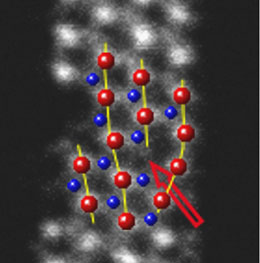Research Abstract
単層二硫化タングステンナノリボンにおける活性な原子欠陥の識別
走査型透過電子顕微鏡法を用いて、環状暗視野像と電子エネルギー損失分光法による、単層二硫化タングステンナノリボンの単一原子を識別し、空格子点や端原子などの動いている原子欠陥を明確に識別し、その可視化に成功した。
Identification of active atomic defects in a monolayered tungsten disulphide nanoribbon
2011年3月1日 Nature Communications 2 : 213 doi: 10.1038/ncomms1224

端(エッジ)構造と原子欠陥は、ナノリボンなどの低次元材料の物理的性質や化学的性質に大きく影響を与えるため、原子スケールでの詳細な研究が必要であ る。今回我々は、走査型透過電子顕微鏡法を用いて、環状暗視野像と電子エネルギー損失分光法による、単層二硫化タングステンナノリボンの単一原子を識別 し、空格子点や端原子などの動いている原子欠陥を明確に識別し、その可視化に成功した。その結果、ナノリボンにおけるすべり変形において空格子点の移動と タングステン原子の再配列が関与していることを示した。塑性変形時の単原子欠陥の観察に成功したのは、今回が初めてである。
- 産業技術総合研究所 ナノチューブ応用研究センター
- 北京大学(中国)
- 日本電子株式会社
Edge structures and atomic defects can significantly affect the physical and chemical properties of low-dimensional materials, such as nanoribbons, and therefore merit a thorough investigation at the atomic scale. Here, we successfully discriminate single atoms on a monolayered tungsten disulphide nanoribbon by means of time-resolved annular dark-field imaging and spatially resolved electron energy-loss spectroscopy. We unambiguously identify and successfully visualize in motion atomic defects, such as vacancies and edge atoms, using scanning transmission electron microscopy. We also report a direct observation of slip deformation in the nanoribbons and present evidence demonstrating that the deformation process involves the migration of vacancies and rearrangement of tungsten atoms. Single-atom defects are successfully observed for the first time during plastic deformation.

